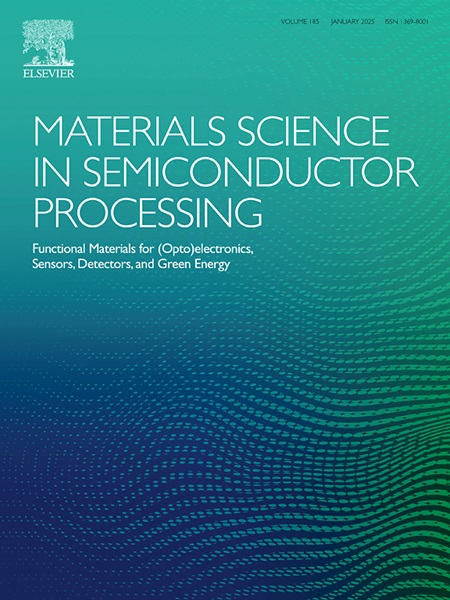通过形成氧空位增强Au/TiO2-CeO2光催化制氢
IF 4.2
3区 工程技术
Q2 ENGINEERING, ELECTRICAL & ELECTRONIC
引用次数: 0
摘要
采用尿素法连续沉积-沉淀法制备了表面修饰Au纳米颗粒的TiO2-CeO2 (TC)材料。能谱分析显示,Ce和Au在TiO2表面有效沉积,CeO2相分布均匀。STEM-HAADF的TiO2与CeO2相接近,形成了尺寸为3.6±0.7 nm的AuNPs。随着CeO2浓度的增加,TiO2带隙(Eg)略有减小。对于TC材料,XPS证实Ti3+浓度略有增加,Ce3+主要存在,这增加了氧空位(OVs)。此外,aunp主要由Au0组成(80.2%)。XPS和光电化学表征表明,加入CeO2和AuNP后,材料的价带边能更高,使得材料中的质子还原在热力学上更有利。在析氢反应方面,Ce质量分数为0.9 wt%时,TC材料的光催化产氢率达到2.3 mmol g−1 h−1,比原始TiO2提高了20%。此外,添加0.7 wt%的AuNPs可以显著提高氢光催化产量,达到10.7 mmol g−1 h−1。这种增强归因于aunp作为电子陷阱的能力,减少了电子-空穴复合。光电化学表征表明,CeO2和AuNPs掺入后,平带电位下降,这也可能与OVs的形成有关。表面的aunp通过形成肖特基结提高了CB中电子的稳定性。本文章由计算机程序翻译,如有差异,请以英文原文为准。
Enhanced photocatalytic hydrogen production on Au/TiO2-CeO2 through the formation of oxygen vacancies
TiO2-CeO2 (TC) materials superficially modified with Au nanoparticles (AuNPs) were prepared using the sequential deposition-precipitation with urea method. EDS revealed the effective deposition of Ce and Au and a well-distributed CeO2 phase on TiO2. STEM-HAADF showed proximity between the TiO2 and CeO2 phases and the formation of AuNPs with a size of 3.6 ± 0.7 nm. The TiO2 band gap (Eg) decreased slightly with the increase in the CeO2 concentration. For the TC materials, XPS confirmed a slight increase in the Ti3+ concentration and the predominant presence of Ce3+, which increased the oxygen vacancies (OVs).
Furthermore, the AuNPs were mainly composed of Au0 (80.2 %). XPS and photoelectrochemical characterizations revealed higher valence band-edge energy after the CeO2 and AuNP incorporation, making proton reduction in the material more thermodynamically favorable. As for the hydrogen evolution reaction, the TC material with optimal Ce loading of 0.9 wt% increased the photocatalytic hydrogen production rate to 2.3 mmol g−1 h−1, 20 % higher than that of pristine TiO2. Additionally, adding 0.7 wt% of AuNPs led to a substantial improvement in hydrogen photocatalytic production, reaching 10.7 mmol g−1 h−1. This enhancement was ascribed to the ability of AuNPs to act as electron traps, reducing the electron-hole recombination. Photoelectrochemical characterization showed a decrease in the flat-band potential upon incorporation of CeO2 and AuNPs, which could also be associated with the formation of OVs. AuNPs on the surface improved the stability of the electrons in the CB through the formation of a Schottky junction.
求助全文
通过发布文献求助,成功后即可免费获取论文全文。
去求助
来源期刊

Materials Science in Semiconductor Processing
工程技术-材料科学:综合
CiteScore
8.00
自引率
4.90%
发文量
780
审稿时长
42 days
期刊介绍:
Materials Science in Semiconductor Processing provides a unique forum for the discussion of novel processing, applications and theoretical studies of functional materials and devices for (opto)electronics, sensors, detectors, biotechnology and green energy.
Each issue will aim to provide a snapshot of current insights, new achievements, breakthroughs and future trends in such diverse fields as microelectronics, energy conversion and storage, communications, biotechnology, (photo)catalysis, nano- and thin-film technology, hybrid and composite materials, chemical processing, vapor-phase deposition, device fabrication, and modelling, which are the backbone of advanced semiconductor processing and applications.
Coverage will include: advanced lithography for submicron devices; etching and related topics; ion implantation; damage evolution and related issues; plasma and thermal CVD; rapid thermal processing; advanced metallization and interconnect schemes; thin dielectric layers, oxidation; sol-gel processing; chemical bath and (electro)chemical deposition; compound semiconductor processing; new non-oxide materials and their applications; (macro)molecular and hybrid materials; molecular dynamics, ab-initio methods, Monte Carlo, etc.; new materials and processes for discrete and integrated circuits; magnetic materials and spintronics; heterostructures and quantum devices; engineering of the electrical and optical properties of semiconductors; crystal growth mechanisms; reliability, defect density, intrinsic impurities and defects.
 求助内容:
求助内容: 应助结果提醒方式:
应助结果提醒方式:


